
Mauricio Santillana
Director, Machine Intelligence Lab,
Assistant Professor, Harvard Medical School,
I am an applied mathematician and physicist with expertise in mathematical modeling and scientific computing. I specialize in the analysis of big data sets in multiple contexts to understand and predict the behavior of complex systems. I also have expertise in the design and analysis of numerical methods to solve partial differential equations (PDEs) for a diverse array of applications.
Implementing and validating methodologies to solve challenging problems, in real-life computational applications, has been central to my research, and has exposed me to the use of high–performance computing environments.
I am interested in designing and implementing novel ways to track epidemics in real-time using data from Google, Twitter, Facebook, UpToDate (digital disease detection). I am conducting research to understand the impact of climate change on disease burden in Africa and Mexico. I have also conducted research in atmospheric pollution transport modeling, climate modeling, modeling of floods due to hurricanes, and population dynamics modeling. The following paragraphs summarize my research contributions.
Our research in the news (updated more frequently here) :
Lessons from the data: Applying machine learning for clinical decision support (Vector, Boston Children’s Hospital, 2017)
Tracking Disease: Digital Epidemiology offers new promise in predicting outbreaks (IEEE Pulse, USA, 2017)
Kids have the flu, grown-ups are next (Athenahealth insight, USA, 2017)
Big Pharma Is Sponsoring A Flu Map On The Weather Channel (BuzzFeed News, USA, 2016)
Traveling this summer? What to know about Zika virus (Miami Herald, USA, 2016)
HealthData management, Science Daily, Politico, EurekAlert!, News Medical, MedCity News, Vector (BCH), Insights Samsung, UPI Health news. Prediction Algorithm Used to Predict Flu Cases in Real Time at Boston’s Children’s Hospital using Electronic Health Records (2016).
Disease Sleuths Analyze Google Searches To Stop Infections (National Public Radio, NPR (USA), 2015)
Neuer Anlauf für die Grippeprognose (Deutschlandfunk (Germany), 2015)
La revanche du big data : Harvard plus forte que Google pour prédire la grippe (Rue89 (France), 2015)
On top of the flu (Harvard Gazette, 2015)
Google, estadística y ‘big data’ para cazar brotes de gripe (Sinc (Spain), 2015)
New flu tracker uses Google search data better than Google (Arstechnica, 2015)
Nowcasting—and Forecasting—Flu: Ensemble modeling could lead to better predictions (Harvard Medical School News, 2015)
Boston Children’s Hospital Used Data Synthesis to Make Real-Time Flu Predictions (Boston Magazine, 2015)
‘Ensemble’ modeling could lead to better flu forecasts, study finds (AAAS, 2015)
Using Social Media to Forecast The Flu (MedTech, 2015)
Twitter, EHR Big Data Help Track Flu with Predictive Analytics (Health IT Analytics, 2015)
Google Flu Trends promises are overstated, researchers say (The Guardian (UK), 2014)
Researchers Suggest Fixes to Google Flu Trends Analytics (Health Data Management, 2014)
Studies Explore New Frontiers of the Impact of UpToDate (UpToDate, 2014)
1. Design and implementation of Digital Disease Detection tools as decision-support tools to help public health officials make timely decisions and prevent epidemic outbreaks.
We are working towards the development of the next generation of digital epidemiolgy tools aimed at monitoring disease outbreaks in real-time. We are constantly developing methodologies that leverage information from multiple data-sources including Google search query patterns, Twitter microblogs, cloud-based electronic health records, weather, and human mobility, to produce real-time and short-term forecast estimates of endemic disease outbreaks of dengue, flu and emerging disease outbreaks such as the 2014 West African Ebola outbreak, the 2014 Latin American Zika outbreak, and the ongoing 2019-nCoV outbreak originated in Wuhan, China. Our real-time estimates are typically available 1-4 weeks earlier than the official CDC-reported flu activity in the US. The Machine Intelligence Lab at Boston Children’s Hospital / Harvard Medical School is our computational laboratory.

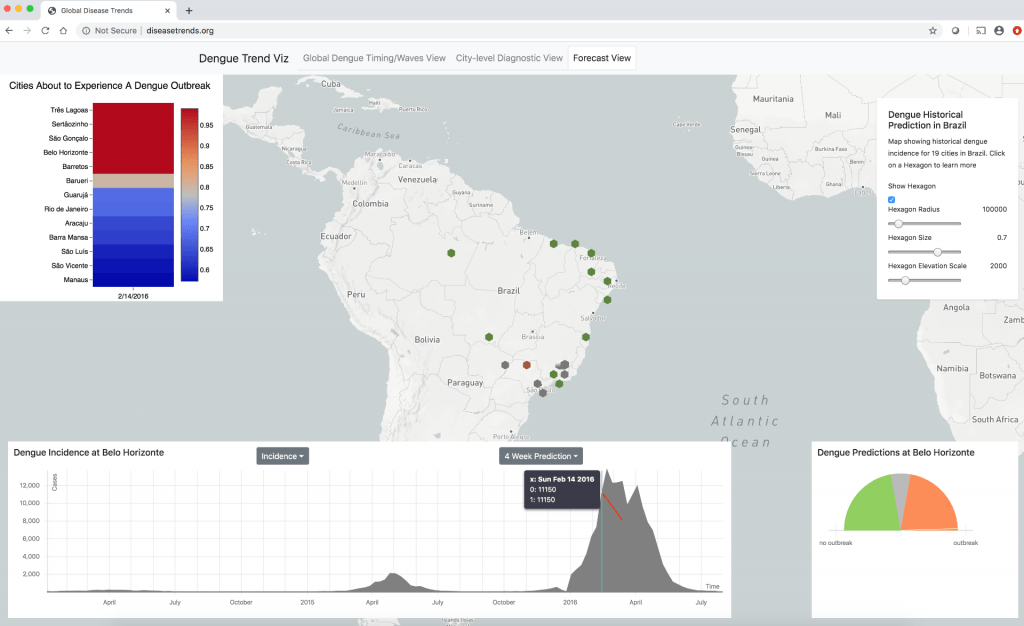
Relevant papers:
20. Lipsitch M and Santillana M. Enhancing Situational Awareness to Prevent Infectious Disease Outbreaks from Becoming Catastrophic. In: Inglesby T Global Catastrophic Biological Risk. Springer, Berlin, Heidelberg. ; 2019.
19. Naveca FG, Claro I, Giovanetti M, Jesus JG, Javier J, Iani FCM, do Nascimento VA, Souza VC, Silveira PP, Lourenco J, et al. Chikungunya virus outbreak in the Amazon region: replacement of the Asian genotype by an ECSA lineage. PLoS Neglected Tropical Diseases. 2019;13 (3) :e0007065.
18*. Clemente LC, Lu F, Santillana M. Improved real-time influenza surveillance using Internet search data in eight Latin American countries. JMIR Public Health Surveillance. 2019;5 (2) :e12214.
17*. Lu F, Hattab M, Clemente L, Santillana M. Improved state-level influenza activity nowcasting in the United States leveraging Internet-based data sources and network approaches via ARGONet. Nature Communications. 2019;10 (147).
16. M. Santillana, A. Tuite, T. Nasserie, P. Fine, D. Champredon L. Chindelevitch, J. Dushoff, D. Fisman. Relatedness of the Incidence Decay with Exponential Adjustment (IDEA) Model, “Farr’s Law” and Compartmental Difference Equation SIR Models. Submitted.
15. S. Yang, M. Santillana, J.S. Brownstein, J. Gray, S. Richardson, S. C Kou. Using electronic health records and Internet search information for accurate influenza forecasting. BMC Infectious Diseases 2017; 17:332
14. K. Baltrusaitis, M. Santillana, A. Crawley, R. Chunara, M. Smolinski, J. Brownstein. Determinants of Participants’ Follow-Up and Characterization of Representativeness in Flu Near You, A Participatory Disease Surveilla. JMIR Public Health Surveillance. 2017;3 (3) :e18
13*. S.F. McGough, J.S. Brownstein, J. Hawkins, M. Santillana. Forecasting Zika Incidence in the 2016 Latin America Outbreak Combining Traditional Disease Surveillance with Search, Social Media, and News Report Data. PLoS Neglected Tropical Diseases 11(1): e0005295.
12*. M. Santillana. Perspectives on the future of Internet search engines and biosurveillance systems. Clinical Infectious Diseases. 64 (1): 42-43. (2017)
11*. M.A. Johansson, N.G. Reich, A. Hota, J. S. Brownstein, and M. Santillana. Evaluating the performance of infectious disease forecasts: A comparison of climate-driven and seasonal dengue forecasts for Mexico. Scientific Reports 6, 33707 (2016)
10. Majumder MS, M. Santillana, Mekaru SR, McGinnis DP, Khan K, Brownstein JS. Utilizing Nontraditional Data Sources for Near Real-Time Estimation of Transmission Dynamics During the 2015-2016 Colombian Zika Virus Disease Outbreak JMIR Public Health Surveillance (2016); 2(1):e30
9. M. Santillana, A.T. Nguyen, T. Louie, A. Zink, J. Gray, I. Sung, and J.S. Brownstein. Cloud-based Electronic Health Records for Real-time, Region-specific Influenza Surveillance. Scientific Reports 6, 25732 (2016)
8. S. Yang, M. Santillana, and S. C. Kou. Accurate estimation of influenza epidemics using Google search data via ARGO. Proceedings of the National Academy of Sciences, 112.47, pp: 14473-14478, 2015. (Preprint in ArXiv)
7. M. Santillana, A. T. Nguyen, M. Dredze, M.J. Paul, E. Nsoesie, and J. S. Brownstein. Combining Search, Social Media, and Traditional Data Sources to Improve Influenza Surveillance. PLOS Computational Biology. 11(10): e1004513, Oct, 2015.
6. M. S. Smolinski, A. W. Crawley, K. Baltrusaitis, R. Chunara, J. M. Olsen, O. Wojick, M. Santillana, A. T. Nguyen, J. S. Brownstein. Flu Near You: Crowdsourced Symptom Reporting Spanning Two Influenza Seasons. American Journal of Public Health. 105 (10), 2124-2130, 2015.
5. M. S. Majumder, S. A. Kluberg, M. Santillana, S. R. Mekaru, and J. S. Brownstein. 2014 Ebola Outbreak: Media events track changes in observed reproductive number. PLoS Currents: Outbreaks. 2015 Apr 28, Edition 1.
4. R. Nagar, Q. Yuan, C. Freifeld, M. Santillana, A. Nojima, R. Chunara, and J. S. Brownstein. A Case Study of the New York City 2012-2013 Influenza Season with Daily, Geocoded Twitter Data from Temporal and Spatiotemporal Perspectives. Journal of Medical Internet Research. 16(10): e236, Nov 2014.
3. M. Santillana, E. O. Nsoesie, S. R. Mekaru, D. Scales, and J. S. Brownstein. Using Clinician’s Search Query Data to Monitor Influenza Epidemics. Clinical Infectious Diseases, 59 (10), pp:1446-1450, 2014.
2. M. Santillana, D.W. Zhang, B.M. Althouse, and J.W. Ayers. What Can Digital Disease Detection Learn from (an External Revision to) Google Flu Trends?. American Journal of Preventive Medicine.Volume 47, Issue 3, pp: 341–347, Sep 2014.
1. R.T. Gluskin, M.A. Johansson, M. Santillana, and J.S. Brownstein. Evaluation of internet-based dengue query data: Google Dengue Trends. PLoS Neglected Tropical Diseases, 8(2): e2713, Feb 2014.
2. Understanding the role of environmental factors on the timing of outbreaks of infectious diseases (Dengue)
The availability of on-line and real-time sources of big data sets gives us the opportunity to monitor how mobility patterns (estimated from mobile phone information) and climate variables (among many other factors) influence the spread of Cholera outbreaks in Africa.

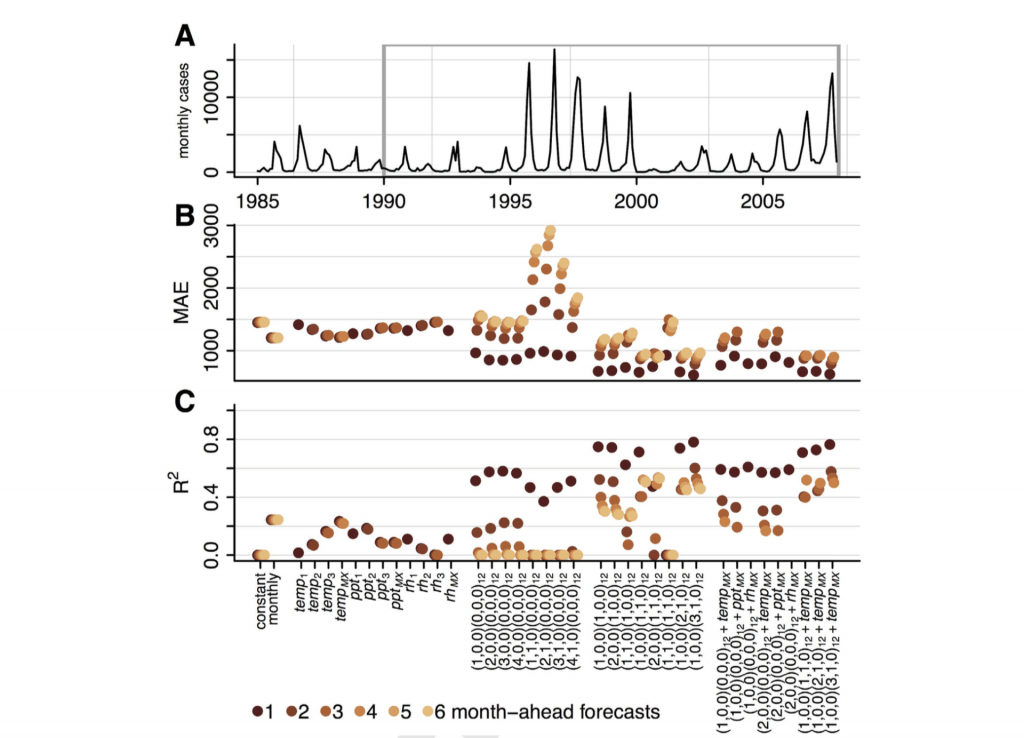
Relevant papers:
3*. McGough S, Kutz NJ, Clemente LC, M. Santillana. Combining weather patterns and cycles of population susceptibility to forecast dengue fever epidemic years in Brazil: a dynamic, ensemble learning approach. bioRxiv. 2019. Submitted.
2*. M.A. Johansson, N.G. Reich, A. Hota, J. S. Brownstein, and M. Santillana. Evaluating the performance of infectious disease forecasts: A comparison of climate-driven and seasonal dengue forecasts for Mexico. Scientific Reports 6, 33707 (2016)
1. R. Gluskin, M. Santillana, and John Brownstein. Using Google Dengue Trends to Estimate Climate Effects in Mexico. Online Journal of Public Health Informatics . Volume 5, No 1, 2013.
3. Global atmospheric chemistry:
A video of a seminar I gave in the Spring 2011 at the Institute for Mathematics and its Applications, at the University of Minnesota regarding my research in Atmospheric Chemistry can be found here.
Understanding the global-scale dynamics of the chemical composition of our atmosphere is essential for addressing a wide range of environmental issues from air quality to climate change. Understanding this phenomenon enables us to evaluate and devise appropriate environmental policies, such as the Kyoto Protocol on global greenhouse gases emissions. Numerical modeling of global atmospheric chemical dynamics presents an enormous challenge associated with simulating hundreds of chemical species with time scales varying from milliseconds to years.
In my research, I have worked on the implementation of computationally efficient algorithms for calculating the time evolution of the concentration of chemical species in global 3-D models of atmospheric chemistry. I have also investigated the efficacy of adjoint based inverse modeling techniques for source attribution problems.
Assessing model errors and uncertainties: I am very interested in understanding the large dependence of the results of Global Atmospheric Chemistry Models on spatial resolution, time stepping, and spatial averaging of meteorological fields, and the impact of these on the contaminant plume propagation.

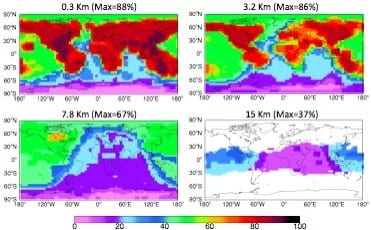
The Figure (right) shows the percentage of chemical species whose production or loss rates are above an activity threshold of 100 molecules cm-3 s-1. Identifying these regions allows the use of more efficient methods to estimate the concentration of species in our planet.
Collaborators: Daniel J Jacob (Harvard), Michael P. Brenner (Harvard), Lin Zhang (U Peking), Philippe Le Sager (KNMI), Claire Carouge (Harvard).
Relevant papers:
3. M. Santillana, L. Zhang, and R. Yantosca. Estimating numerical errors due to operator splitting in global atmospheric chemistry models. Journal of Computational Physics 305 (2016) 372–386. (Preprint in ArXiv about Estimating numerical errors due to operator splitting in global atmospheric chemistry models)
2. M. Santillana. Quantifying the loss of information in source attribution problems using the adjoint method in global models of atmospheric chemical transport.
1. M. Santillana, P. Le Sager, D. J. Jacob, and M. P. Brenner. An adaptive reduction algorithm for efficient chemical calculations in global atmospheric chemistry models. Atmospheric Environment. Volume 44, Issue 35, pp 4426-4431, Nov 2010.
4. Shallow water modeling:
As a consequence of our changing climate, large efforts have been made to understand the social risks of storm surges (hypothesized to increase in frequency in warmer climate scenarios) and sea level rise in coastal areas. Of particular interest is the role that wetlands and coastal marshes play in storm surges and flooding events.
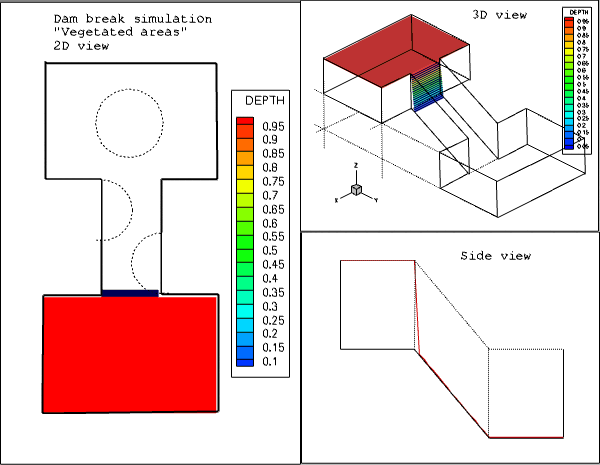
For example, coastal marshes and swamps act as a buffer zone between the Gulf of Mexico and inhabited inland areas in Louisiana, where an estimated 60-75 % of residents live within 50 miles of the coast (1993) and where, between 1899 and 1995, over a dozen major hurricanes (class 3-5) have hit (with the two most recent hits being the category 5 hurricanes Katrina and Rita in 2005). Understanding the role of these rich biological ecosystems in our changing climate requires the development of appropriate mathematical models.
In my research, I have studied analytically and numerically an effective equation often referred to in the literature as the diffusive wave approximation of the shallow water system of equations (DSW), used to simulate overland flow in wetlands and open channels. This equation is obtained by approximating the depth averaged continuity equations by empirical laws such as Manning’s or Chezy’s formulas and then combining the resulting expression with the free surface boundary condition.
I have studied the properties of approximate (weak) solutions to the DSW using the continuous and discontinuous (LDG) Galerkin method, developing error estimates and implementing a 2-D code aimed at simulating water flow on experimental settings as well as real environments. I have also investigated inverse modeling approaches to estimate friction coefficients using the DSW as a physical model.
Collaborators: Clint Dawson (UT Austin), Ricardo Alonso (Rice), Marco A. Iglesias (U of Warwick), Victor M. Calo (KAUST), Andres Concha (U Adolfo Ibañez, Chile)
Relevant papers:
6. V.M. Calo, N. Collier, M. Gehre, B. Jin, H. Radwan, and M. Santillana. Gradient-based estimation of Manning’s friction coeficient from noisy data. Journal of Computational and Applied Mathematics, 238, pp 1–13, Jan 2013.
5. H. G. Radwan, P. Vignal, N. Collier, L. Dalcin, M. Santillana, and V.M. Calo. Convergence rates for the Diffusive Shallow Water Equations (DSW) using higher order polynomials. Journal of the Serbian Society of Computational Mechanics, Vol. 6, No. 1, Nov 2012
4. M. Santillana and C. Dawson. A local discontinuous Galerkin method for a doubly nonlinear diffusion equation arising in shallow water modeling. Computer Methods in Applied Mechanics and Engineering. Volume 199, Issue 23, pp. 1424-1436, Apr 2010.
3. M. Santillana and C. Dawson. A numerical approach to study the properties of solutions of the diffusive wave approximation of the Shallow Water equations. Computational Geosciences. Volume 14, Issue 1, pp 31-53. Jan 2010.
2. R. Alonso, M. Santillana, and C. Dawson. On the diffusive wave approximation of the Shallow Water equations. European Journal of Applied Mathematics. Volume 19, Issue 5, Oct 2008, pp 575-606.
1. M. Santillana. PhD. Dissertation: Analysis and Numerical Simulation of the Diffusive Wave Approximation of the Shallow Water Equations. Advisor: Clint Dawson. 7/2008
5. Past climate dynamics
Using climate models has become our main tool for estimating possible future climate scenarios. Frequently, when using our current climate models to simulate past climate events and the physical mechanisms behind them, we realize the limits of our understanding of the complex Earth system. As our Earth experiences higher CO2 scenarios, the IPCC Report in 2007 has stressed the need to study the role of cloud feedbacks in the radiative processes of our atmosphere. These feedbacks are not well understood and present one of the key uncertainties in our climate models.

My research in this field has consisted of examining the role of cloud feedbacks in the warming of continental interiors over North America during the high-CO2 Eocene period (55-35 million years ago). To this end, I have used a cloud resolving model (the state-of-the-art Weather Research & Forecasting modeling system, WRF) over a patch of the Earth containing North America, and prescribed lateral boundary conditions from a Eocene-like run using the CAM AGCM (NCAR Community Atmospheric Model) in high-CO2 concentration scenarios. Preliminary results in coarse resolution (Cloud Radiative Forcing CRF is shown in figure above) runs using WRF, show disagreement with previous proposed cloud feedback mechanisms over marine regions as well as continental interior regions, and open the possibility for alternative explanations.
Collaborators: Eli Tziperman (Harvard), Dorian Abbot (U of Chicago), Chris Walker (Harvard).
Relevant poster:
1. M. Santillana, E. Tziperman, D.S. Abbot, and C. Walker The Role of Cloud Feedbacks in the Warming of Continental Interiors in the Eocene. European Research Course on Atmospheres, Universite Joseph Fourier, Grenoble, France 1/2010. (Poster in PDF about The Role of Cloud Feedbacks in the Warming of Continental Interiors in the Eocene)
6. Mathematical modeling in Geographic Information Science (GIS):
Land use modeling: Changes in land use across the world frequently lead to the degradation of both natural and social environments. Understanding the dynamics of this phenomenon would allow policy-makers to foresee the impact of inaction and design timely measures in order to minimize environmental risks and degradations of our surroundings.
My research in this area consisted in designing a mathematical model of land use change for a particular ecologically-sensitive area in the outskirts of Mexico City. In this location, disordered and non-regulated urban growth represented (and currently represents) a ma jor problem since the recharge of the city’s aquifer has increasingly been blocked by human constructions. The goals of our work included providing decision-making agencies with a suitable tool to generate probable scenarios of urban development based on a given set of hypothetical conditions, such as the implementation of urban policies or urban infrastructure developments. In this study we combined techniques from remote sensing, analysis of aerial pictures, cellular automata-based modeling, and optimization algorithms to calibrate our models. The methodology that we formulated was later applied to El Paso, Texas as a tool to forecast population growth and eventually used to estimate water demand in future scenarios.
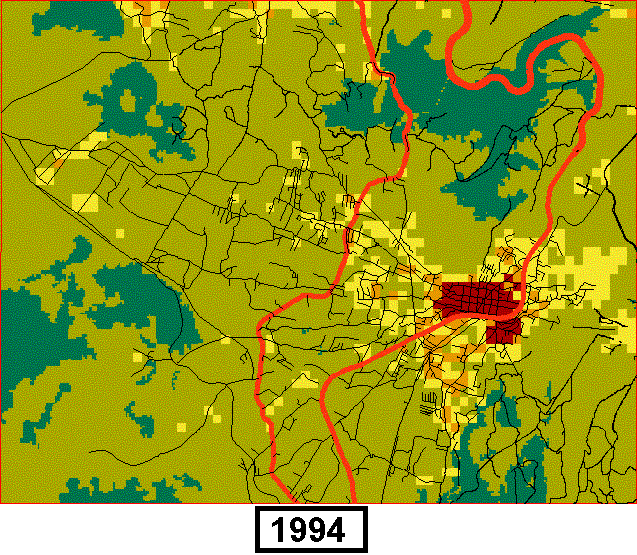
Collaborators: Benjamin Zhan (Texas SU), Fidel Serrano y Candela (CentroGeo), Omar Tapia (CentroGeo), Carmen Reyes (CentroGeo).
Relevant papers:
2. B. Zhan, O. Tapia, and M. Santillana. Estimating Small Area Population Growth Using Geographic Knowledge Guided Cellular Automata. International Journal of Remote Sensing. Volume 31, Issue 21, 5689, Jul 2010.
1. M. Santillana and F. Serrano. Calibration and validation of a CA based model using an evolutionary algorithm for urban development simulation. A case study in Mexico City. Proceedings of the Ninth International Conference on Computers in Urban Planning and Urban Management (CUPUM 2005). University College London, London, UK. 6/2005.
7. Quantum Mechanics/ Calculus of variations
My research in this area consisted of identifying the variational principles in Hamiltonian physics that gave rise to the conception of Quantum Mechanics. In this work I explored the ways in which Newtonian physics can be seen as minimizer of the Hamiltonian, and how Feynman’s path integrals contain (assymptotically) quantum mechanics and Hamiltonian mechanics.
Relevant papers:
1. M. Santillana. Bachelor’s/MS Degree Thesis: From Classical Mechanics to Quantum Mechanics. A variational Perspective. Advisor: Professor Pablo Padilla Longoria. (In Spanish). 7/2001.